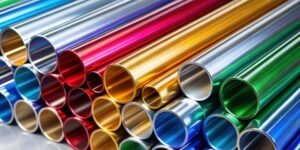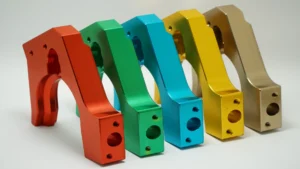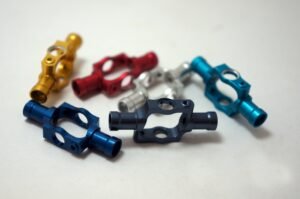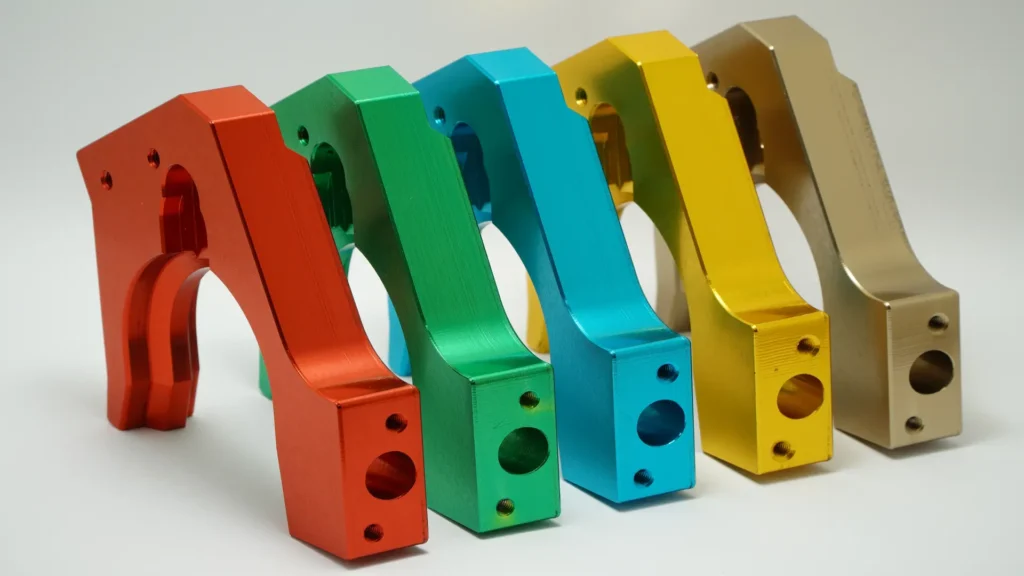Introduction to Anodized Aluminum
Anodized aluminum is aluminum that has undergone surface treatment through anodizing – an electrochemical process that creates a thin, durable oxide layer on the metal’s surface. This layer not only protects the aluminum from corrosion and wear but also enhances its appearance, heat resistance, and electrical insulation properties.
Unlike surface coating methods such as painting or plating, the anodized layer is formed from the aluminum itself, resulting in superior adhesion, no peeling, and exceptional durability.
The Importance of Anodizing in Manufacturing, Industry, and Architecture
Today, aluminum is widely used due to its lightweight, excellent thermal conductivity, and ease of machining. However, raw aluminum is prone to oxidation, scratching, and corrosion when exposed to the environment over time. This makes anodizing an essential treatment process across various industries, including:
- Manufacturing & Industrial Applications: Protects aluminum components and machinery parts in harsh environments, extending product lifespan.
- Construction & Architecture: Aluminum used for doors, curtain walls, railings, etc., benefits from anodizing with a long-lasting, aesthetically pleasing finish.
- Electronics & Home Appliances: From phone and laptop casings to cookware like non-stick pots and pans, anodizing enhances surface hardness, color stability, and safety for everyday use.
What is Anodized Aluminum?
Anodizing is a specialized electrochemical process used to create a durable and protective aluminum oxide layer on the surface of aluminum. Unlike coating methods such as painting or plating, the anodized layer is not an added material, it forms naturally from the aluminum itself through a chemical reaction.
Key characteristics of the anodized layer include:
- Very Thin: Typically ranges from a few microns to several dozen microns in thickness.
- Extremely Durable: Highly resistant to corrosion, with excellent hardness.
- Color Customization: Can be dyed in various colors for aesthetic or identification purposes.
- No Peeling or Flaking: Unlike paint or plating, the anodized layer is bonded directly to the metal substrate, ensuring long-term adhesion.

How Does the Anodizing Process Work?
The anodizing process typically involves the following key steps:
1. Surface Cleaning: The aluminum surface is cleaned using mild acidic or alkaline solutions to remove grease, oil, and dust.
2. Degreasing & Chemical Brightening (optional depending on the application)
3. Anodizing: The aluminum is submerged in a diluted sulfuric acid bath and connected to the positive electrode (anode), while the negative electrode (cathode) is typically a different metal.
When an electric current is applied:
-
- Oxygen is released at the aluminum surface, reacting to form an aluminum oxide layer (Al₂O₃).
- The oxide layer grows uniformly with a fine, porous, honeycomb-like structure.
- Oxygen is released at the aluminum surface, reacting to form an aluminum oxide layer (Al₂O₃).
4. Coloring (Optional): Dye is absorbed into the microscopic pores of the oxide layer for decorative or functional purposes.
5. Sealing: The pores are sealed using hot water or special sealing solutions to lock in the color, enhance corrosion resistance, and prevent contamination.
Common Types of Anodizing
Anodizing is classified into several types based on the MIL-A-8625 U.S. military standard. The most common types include:
Type I – Chromic Acid Anodizing
- Produces the thinnest oxide layer (~0.5–1 µm)
- Mainly used in aerospace and defense industries
- Offers good corrosion resistance but lower mechanical strength
- Minimal dimensional change to the aluminum part
Type II – Sulfuric Acid Anodizing
- The most widely used type in industrial and consumer applications
- Medium layer thickness (~5–25 µm)
- Can be dyed in various colors
- Commonly used in interior design, electronics, and precision mechanical parts
Type III – Hard Anodizing (Hardcoat Anodizing)
- Produces a much thicker oxide layer (typically >25 µm, up to 100 µm)
- Extremely high hardness (up to 500–800 HV)
- Ideal for high-performance applications, machinery parts, and components exposed to wear and heat

How Is Anodizing Different from Painting, Plating, or Other Surface Treatments?
When it comes to surface treatment for aluminum and other metals, there are various methods available such as powder coating, electroplating, and chemical plating. However, anodizing stands out with several unique advantages:
Anodizing creates a protective oxide layer directly on the aluminum surface. This layer is not an additional coating like paint or plating—it is chemically bonded to the base metal, making it highly durable and non-peeling.
Powder Coating offers a wide range of colors and aesthetic finishes, but it may peel or chip under impact or harsh environmental exposure.
Electroplating (e.g., zinc or nickel plating) adds a thin layer of another metal onto the surface, but it may delaminate over time if the base surface isn’t properly prepared.
Chemical Plating is often used for small precision parts, but it typically comes at higher costs and is less durable outdoors compared to anodized aluminum.
In summary, anodizing is preferred because it offers:
- Long-lasting color without peeling or flaking
- Outstanding corrosion resistance
- Enhanced hardness and product longevity
- Aesthetic flexibility with color customization
Key Advantages of Anodized Aluminum
Anodized aluminum not only looks better but also gains substantial technical improvements after treatment. Below are the main reasons why anodized aluminum is increasingly favored across industries—from construction to consumer electronics:
1. Exceptional Durability and Corrosion Resistance
The aluminum oxide layer formed during anodizing protects the surface from oxidation, salt spray, light acids, and extreme weather conditions.
It’s ideal for outdoor use, coastal environments, and in demanding industries like mechanical engineering, medical devices, automotive, and marine applications.
2. Enhanced Aesthetics: Color Variety & High-Quality Finishes
Anodizing allows for uniform color dyeing directly into the oxide layer with excellent color retention.
The surface finish can be customized—matte, glossy, or brushed (hairline)—to meet diverse design needs in interior decor, electronic casings, and fashion accessories.
3. Excellent Electrical Insulation for Safe Electronics Use
Raw aluminum is conductive, but the anodized surface becomes a natural electrical insulator, improving safety in electrical and electronic applications.
This is why anodized aluminum is commonly used in heat sinks, electronic components, LED housings, and solar battery systems.
4. High Heat Resistance
Depending on oxide layer thickness, anodized aluminum can withstand temperatures of up to 400–500°C, making it ideal for industrial applications where heat resistance is critical.
It resists discoloration and structural damage even with prolonged thermal exposure.
5. Environmentally Friendly and 100% Recyclable
Aluminum is highly recyclable, and the anodizing process uses no toxic or hazardous chemicals, making it environmentally responsible.
Even after its life cycle, anodized aluminum can be recycled without losing material quality.
Applications of Anodized Aluminum in Real-World Industries
1. In Industrial Machinery and Mechanical Equipment
Anodized aluminum is widely used in mechanical parts and industrial equipment due to its superior abrasion resistance, corrosion resistance, and heat tolerance. Common applications include:
- CNC machine components, presses, packaging machines
- Frames, supports, and casings for manufacturing equipment
- Guide rails, protective covers, and sliding tracks
- Tools and accessories used in harsh factory environments
The anodized layer not only protects the surface but also enhances the clean and professional appearance of equipment.

2. In Construction (Curtain Walls, Doors, Ceilings)
In the construction industry, anodized aluminum is favored for its durability, long-lasting color stability, and excellent resistance to oxidation:
- Door and window frames, partitions, curtain wall facades
- Decorative aluminum profiles for interior and exterior applications
- Aluminum ceiling panels, sunshades, wall claddings
- Premium sliding and hinged doors with elegant, uniform finishes
Using anodized aluminum helps extend the lifespan of buildings and reduce long-term maintenance costs.
3. In Electronics (Phone and Laptop Casings)
Anodized surfaces are widely used in high-end electronics for their lightweight protection and aesthetic value:
- Casings for smartphones, laptops, tablets
- Frames and structural parts in consumer electronic devices
- Aluminum heat sinks in circuit boards and cooling systems
The anodized surface not only resists scratches but also allows for custom coloring, enhancing brand identity and product appeal.
4. Other Premium Applications
- Aerospace: Aircraft frame components, control equipment requiring high strength and low weight
- Automotive & Motorcycles: Decorative trims, handlebars, pedals, heat sinks
- Medical Equipment: Surgical tools, diagnostic device frames needing hygiene and durability
- High-End Furniture: Handles, table legs, and luxury decorative aluminum accessories
Why Choose AMS Vietnam as Your Trusted Anodized Aluminum Supplier?
1. High-Quality Anodizing Process – International Standards
- Anodized layer thickness controlled between 5–25 µm, suitable for both decorative and technical use.
- Consistent color tone across production batches, minimizing color variation in mass production.
- Surface finishes meet industry standards for smoothness, gloss, scratch resistance, and corrosion protection.
2. Experienced Technical Team
- Over 5 years of experience in aluminum processing and surface treatment, with deep expertise in anodizing.
- Dedicated technical consulting—from design stage to final production.
- Support in cost optimization and providing efficient manufacturing solutions.
3. Flexible Production Capacity
- Accept orders from small to large volumes, serving both domestic and international customers
- Capability to meet custom technical requirements: color, thickness, gloss level, specialized corrosion resistance
- Modern equipment and technology, ensuring on-time delivery and consistent quality
4. Competitive Pricing & Fast Delivery
- Transparent and reasonable pricing policy, supporting businesses in product development phases
- Optimized production process shortens lead times and ensures on-time delivery, even for urgent orders
